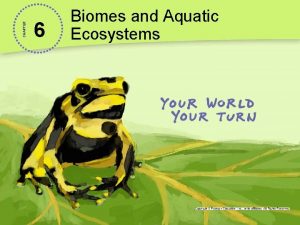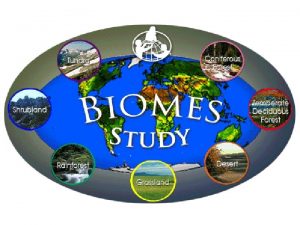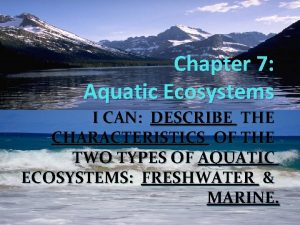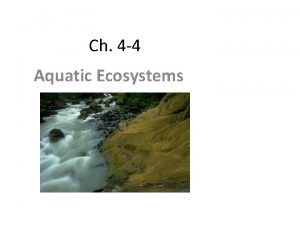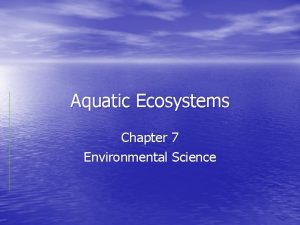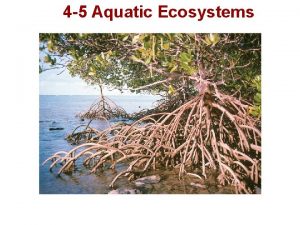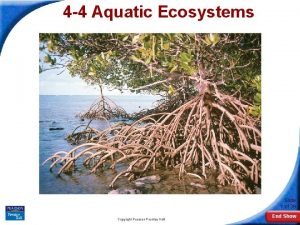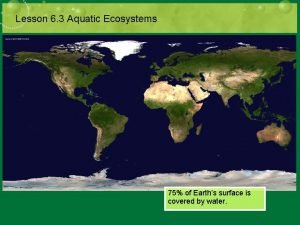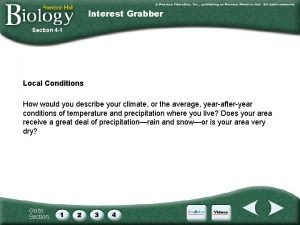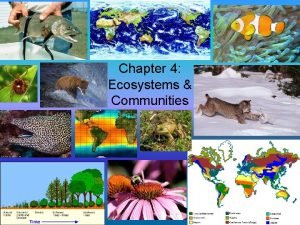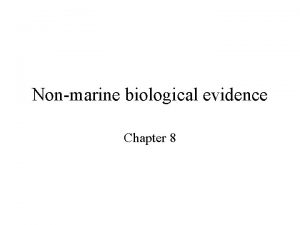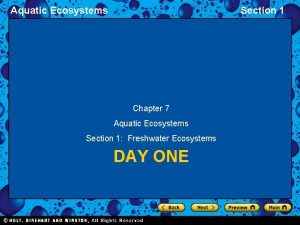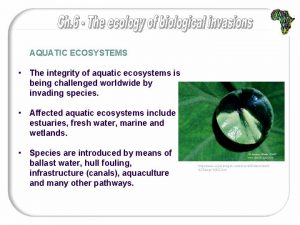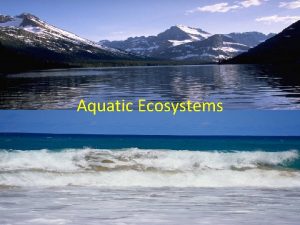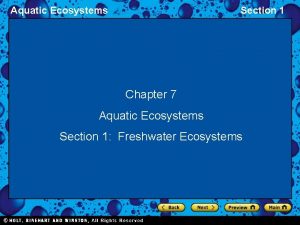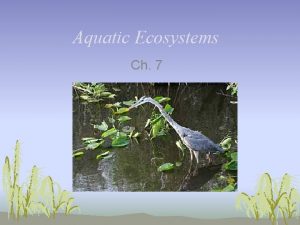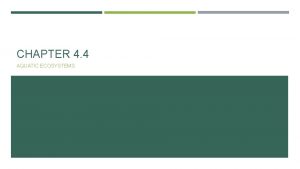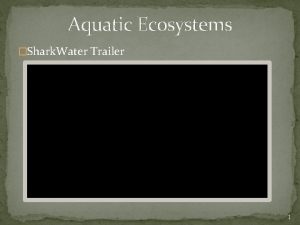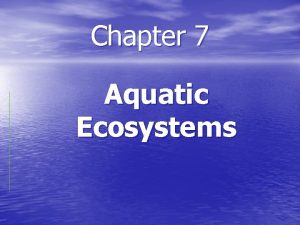National Reserve System and nonmarine aquatic ecosystems Presented



















- Slides: 19


National Reserve System and non-marine aquatic ecosystems Presented by: Tim Bond Science Coordinator National Reserve System Section

About the NRS • The National Reserve System is Australia's network of protected areas, conserving examples of our native ecosystems, plants and animals for future generations. • Its a natural safety net against our biggest environmental challenges; climate change and declining water availability. • It is one of the world's great conservation partnerships. • The NRS includes more than 9, 000 protected areas ranging from huge national parks, Indigenous lands and conservation NGO properties to conservation areas on working farms. • In all, over 90 million hectares are now protected - more than 11 per cent of the continent. • Building the NRS is one of the six national priorities under Caring for our Country.

Caring for our Country A well managed, comprehensive, adequate and representative National Reserve System • $180 million – NRS • $50 million – IPAs • 25% increase in the area of the NRS • 25 million hectares (8 – 16 m ha IPA) • 20 new IPAs

What’s funded • Purchase of land to establish protected areas • Perpetual Conservation Covenanting of land • Projects to establish or support the establishment of protected areas on private land • Establishing and managing IPAs on Aboriginal land

Australian Protected Areas

Imperatives for AEs • Directions for the National Reserve System Direction 7 to better include freshwater ecosystems in the NRS • National Framework for the identification and management of high conservation value aquatic ecosystems • National Water Initiative – water for the environment • International obligations to protect representative wetlands (Ramsar) and migratory waders and waterbirds (CAMBA, JAMBA, ROKAMBA and East Asian-Australasian shorebird site network )

Scientific framework The systematic development of a comprehensive adequate and representative National Reserve System rests on a scientific framework. The scientific framework has a series of fundamental components: – Bioregional Framework (IBRA) – Extent of Protected Areas (CAPAD) – Bioregional assessment of Australia's biological diversity – Guidelines for prioritising biodiversity values – Targets for achieving comprehensiveness and representativeness – Method for assessing adequacy – Ongoing review of the impacts of threatening processes such as climate change and water availability – Methods for assessing the potential contribution of individual properties – Management effectiveness framework including adaptive management, monitoring and reporting – Information on the nature and extent of biodiversity values

Bioregional Framework

IBRA regions

CAR Comprehensive: examples of all types of regional-scale ecosystems in each IBRA region should be included in the National Reserve System. Adequate: sufficient levels of each ecosystem should be included within the protected area network to provide ecological viability and to maintain the integrity of populations, species and communities. Representative: the inclusion of areas at a finer scale, to encompass the variability of habitat within ecosystems.

Achieving CAR Comprehensiveness: – 80% of regional ecosystems in each IBRA region represented by 2015 Representativeness: – 80% of regional ecosystems in each IBRA subregion represented by 2020 Adequacy: – Ecological connectivity – Climate change adaptation – Effective management

Additions to the NRS Focus on the comprehensiveness of under-represented bioregions that have less than 10% of their area protected in reserves. Priority will be given to projects that: – add to the representativeness of the National Reserve System; – will improve resilience and ecological connectivity of biodiversity within the landscape; – ensure greater adequacy of bioregions by providing long-term and increased security for one or more ecosystems and associated species; – add areas that have significant biodiversity values such a high diversity of ecosystems or species, centres of endemism, containing significant habitat for rare, migratory or threatened species; – identify target areas based upon a strategic assessment of reserve options and meeting key reserve system design criteria; – consider and address Indigenous interests, socio-economic interests and scientific importance; – are feasible in terms of an area’s availability and cost-effective in terms of acquisition, establishment and management; and – demonstrate the ability of the organisation to manage and mitigate threatening processes and ensures persistence of ecosystems and species over time.

Bioregional Approach To achieve an integrated landscape result the NRS advocates a bioregional approach. – Based on IBRA regions or subregions – Biodiversity values and associated social and economic values – Integrity – resilience, CAR, climate change, ecological connectivity – Management – mechanisms, capacity and integration with NRM (Cfo. C) Examples – Clarence lowlands wetlands – SEQ LGAs

Governance of protected areas Government % of Aus 9. 4% Ave size 10, 600 ha Number 6, 800 IPA % of Aus 1. 9% Ave size 695, 000 ha Number 25 Private % of Aus 0. 3% Ave size 1, 300 ha Number 2, 000

Protection of IBRA regions 35 IBRA regions that have less than the CBD target of 10% 50 IBRA regions exceed this target Range from Tasmania West at more than 84% to Finke in central Australia at only 0. 03% protected

Protection of IBRA sub regions 44 sub regions (or nearly 11%) without representation in the NRS 144 sub regions have less than 5% representation in the NRS

Australian Government Structure Australian Government Council of Australian Governments (COAG) State and Territory Governments Australian LGA representation Natural Resource Management Ministerial Council Natural Resource Management Standing Committee Natural Resource Policies and Programs Committee NGO National Reserve System Task Group CSIRO National Reserve System Scientific Advisory Sub Group

Key Documents • Convention on Biological Diversity – Program of works – Millennium targets • • National Biodiversity Strategy National Forest Policy (JANIS) Guidelines for Establishing the NRS Directions for the NRS – A Partnership Approach • The Implications of Climate Change for the NRS– a Preliminary Assessment • www. environment. gov. au/parks/nrs/index. html
 Savanna biome plants
Savanna biome plants Chapter 6 biomes and aquatic ecosystems
Chapter 6 biomes and aquatic ecosystems Chapter 3 lesson 3 biomes and aquatic ecosystems
Chapter 3 lesson 3 biomes and aquatic ecosystems Frog life cycle
Frog life cycle Biomes and aquatic ecosystems
Biomes and aquatic ecosystems Source of capital reserve
Source of capital reserve Difference between capital reserve and reserve capital
Difference between capital reserve and reserve capital Lesson outline lesson 2 aquatic ecosystems answer key
Lesson outline lesson 2 aquatic ecosystems answer key Aquatic areas
Aquatic areas What are the two main types of aquatic ecosystems
What are the two main types of aquatic ecosystems Section 4-4 aquatic ecosystems
Section 4-4 aquatic ecosystems 4-4 aquatic ecosystems
4-4 aquatic ecosystems Limestone ridges built by tiny animals
Limestone ridges built by tiny animals 4-4 aquatic ecosystems
4-4 aquatic ecosystems Section 4-4 aquatic ecosystems
Section 4-4 aquatic ecosystems Chapter 7 aquatic ecosystems test answers
Chapter 7 aquatic ecosystems test answers Lesson 3: aquatic ecosystems
Lesson 3: aquatic ecosystems Section 4-4 aquatic ecosystems
Section 4-4 aquatic ecosystems Ecosystem webquest 5th grade
Ecosystem webquest 5th grade Section 4-4 aquatic ecosystems
Section 4-4 aquatic ecosystems

